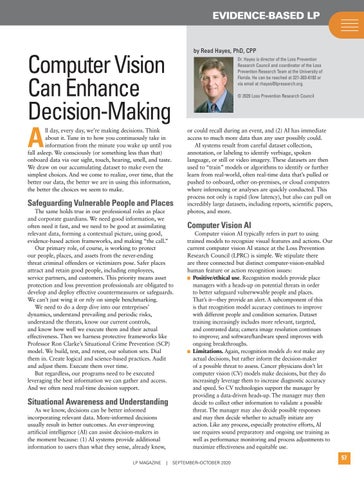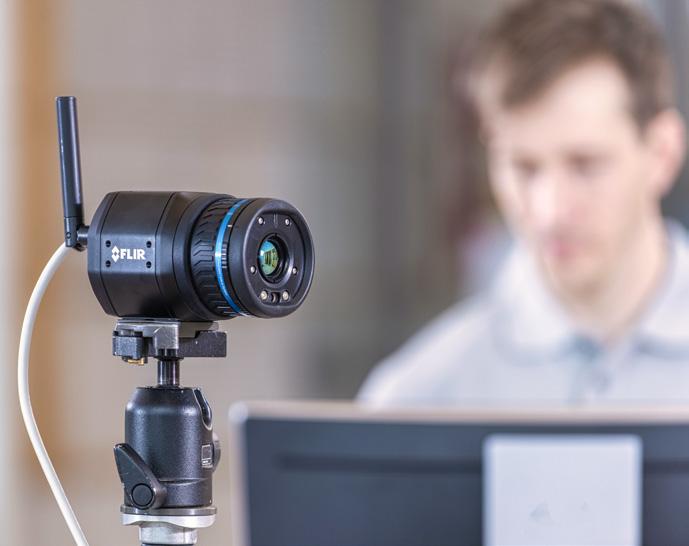EVIDENCE-BASED LP
by Read Hayes, PhD, CPP
Computer Vision Can Enhance Decision-Making
Dr. Hayes is director of the Loss Prevention Research Council and coordinator of the Loss Prevention Research Team at the University of Florida. He can be reached at 321-303-6193 or via email at rhayes@lpresearch.org. © 2020 Loss Prevention Research Council
A
ll day, every day, we’re making decisions. Think about it. Tune in to how you continuously take in information from the minute you wake up until you fall asleep. We consciously (or something less than that) onboard data via our sight, touch, hearing, smell, and taste. We draw on our accumulating dataset to make even the simplest choices. And we come to realize, over time, that the better our data, the better we are in using this information, the better the choices we seem to make.
Safeguarding Vulnerable People and Places
The same holds true in our professional roles as place and corporate guardians. We need good information, we often need it fast, and we need to be good at assimilating relevant data, forming a contextual picture, using good, evidence-based action frameworks, and making “the call.” Our primary role, of course, is working to protect our people, places, and assets from the never-ending threat criminal offenders or victimizers pose. Safer places attract and retain good people, including employees, service partners, and customers. This priority means asset protection and loss prevention professionals are obligated to develop and deploy effective countermeasures or safeguards. We can’t just wing it or rely on simple benchmarking. We need to do a deep dive into our enterprises’ dynamics, understand prevailing and periodic risks, understand the threats, know our current controls, and know how well we execute them and their actual effectiveness. Then we harness protective frameworks like Professor Ron Clarke’s Situational Crime Prevention (SCP) model. We build, test, and retest, our solution sets. Dial them in. Create logical and science-based practices. Audit and adjust them. Execute them over time. But regardless, our programs need to be executed leveraging the best information we can gather and access. And we often need real-time decision support.
Situational Awareness and Understanding As we know, decisions can be better informed incorporating relevant data. More-informed decisions usually result in better outcomes. An ever-improving artificial intelligence (AI) can assist decision-makers in the moment because: (1) AI systems provide additional information to users than what they sense, already knew, LP MAGAZINE
|
or could recall during an event, and (2) AI has immediate access to much more data than any user possibly could. AI systems result from careful dataset collection, annotation, or labeling to identify verbiage, spoken language, or still or video imagery. These datasets are then used to “train” models or algorithms to identify or further learn from real-world, often real-time data that’s pulled or pushed to onboard, other on-premises, or cloud computers where inferencing or analyses are quickly conducted. This process not only is rapid (low latency), but also can pull on incredibly large datasets, including reports, scientific papers, photos, and more.
Computer Vision AI
Computer vision AI typically refers in part to using trained models to recognize visual features and actions. Our current computer vision AI stance at the Loss Prevention Research Council (LPRC) is simple. We stipulate there are three connected but distinct computer-vision-enabled human feature or action recognition issues: ■ Positive/ethical use. Recognition models provide place managers with a heads-up on potential threats in order to better safeguard vulnerwwable people and places. That’s it—they provide an alert. A subcomponent of this is that recognition model accuracy continues to improve with different people and condition scenarios. Dataset training increasingly includes more relevant, targeted, and contrasted data; camera image resolution continues to improve; and software/hardware speed improves with ongoing breakthroughs. ■ Limitations. Again, recognition models do not make any actual decisions, but rather inform the decision-maker of a possible threat to assess. Cancer physicians don’t let computer vision (CV) models make decisions, but they do increasingly leverage them to increase diagnostic accuracy and speed. So CV technologies support the manager by providing a data-driven heads-up. The manager may then decide to collect other information to validate a possible threat. The manager may also decide possible responses and may then decide whether to actually initiate any action. Like any process, especially protective efforts, AI use requires sound preparatory and ongoing use training as well as performance monitoring and process adjustments to maximize effectiveness and equitable use.
SEPTEMBER–OCTOBER 2020
57







